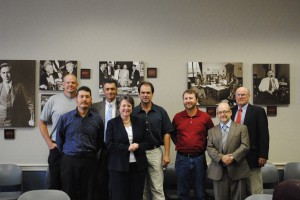On Wednesday, July 20, ten farmers from across the country converged on Washington, D.C. to speak with USDA officials and legislators about making sustainable agriculture a budget priority. Amidst the current uncertainty about deficit-reduction budget cuts, Congress is finalizing its fiscal year 2012 appropriations, while federal agencies begin preparing their budget requests for fiscal year 2013.
Deputy Secretary Kathleen  Merrigan (pictured left with fly-in participants and Organic and Sustainable Agriculture Policy Advisor Mark Lipson) listened to the farmers’ experiences and concerns with programs through the National Institute of Food and Agriculture, Agricultural Marketing Service (AMS), Farm Service Agency (FSA), Natural Resources Conservation Service (NRCS), and Rural and Business Cooperative Service (RBCS). Noting the tough budget climate, Deputy Secretary Merrigan lamented the lack of distinction between useful safety nets and wasteful subsidy programs. However, she said, “Out of crisis comes opportunity.”
Merrigan (pictured left with fly-in participants and Organic and Sustainable Agriculture Policy Advisor Mark Lipson) listened to the farmers’ experiences and concerns with programs through the National Institute of Food and Agriculture, Agricultural Marketing Service (AMS), Farm Service Agency (FSA), Natural Resources Conservation Service (NRCS), and Rural and Business Cooperative Service (RBCS). Noting the tough budget climate, Deputy Secretary Merrigan lamented the lack of distinction between useful safety nets and wasteful subsidy programs. However, she said, “Out of crisis comes opportunity.”
The farmers also met with:
- Ann Bartuska, Deputy Undersecretary for Research, Education, and Economics
- Dallas Tonsager, Under Secretary for Rural Development
- Jason Weller, Chief of Staff for NRCS
- Karis Gutter, Acting Deputy Secretary for Farm and Foreign Agriculture Service
Jonny Harris, a diversified livestock and grain producer from southeast Georgia whose family has farmed since 1860, talked about the potential for a Sustainable Agriculture Research and Education (SARE) grant project, a program of the National Institute of Food and Agriculture, to develop cover crops that can be used for forage, giving farmers a local source of feed and income.
Randy Williams, a beef grazier from Arkansas, compared the soil quality on his farm with that of his neighbors who do not employ conservation practices encouraged through Natural Resources Conservation Services programs. “When the wind comes through, it looks like they have a fire” because of the clouds of dust, he said.
Tom Nuessmeier, a grain and livestock producer from southern Minnesota, described how he has changed his crop rotation and integrated pest management practices as a result of his participation in the Conservation Stewardship Program, emphasizing how it is improving his environmental performance as well as his bottom line.
Laura Paine, a grass-fed beef producer from Wisconsin and part of a cooperative of producers, discussed their application for a Value-Added Producer Grant (VAPG) through the Rural and Cooperative Development Service (RBCS) and what a difference it would make for their business. The working capital would “tip the balance from struggling to successful.” However, she noted that the requirement that the grant’s funds not only be matched by the applicant but also backed by a local bank effectively excludes many producers from the grant.
Dina Brewster, a vegetable CSA farmer from Connecticut, smiled as she claimed “I basically put myself through ag school on ATTRA” (Appropriate Technology Transfer for Rural Areas, or the National Sustainable Agriculture Information Service), and many other farmers supported her sentiments. ATTRA, a program of RBCS, provides critical support and a reliable source of information to farmers and Extension agents across the country.
Daniel Zamora, a beginning organic strawberry farmer from California, described his passion for agriculture and how the pilot Individual Development Account matched savings program conducted by California FarmLink helped him purchase a used tractor from his local dealership. The Beginning Farmer and Rancher Individual Development Account, authorized in the 2008 Farm Bill’s Farm Service Agency programs but never funded, was high on his list of programs needing support from USDA.
Many of the farmers commented on the importance of up-to-date information specifically about the prices for organic products. They asked for the expansion of the Organic Production and Market Data Initiative, a program of the 2002 Farm Bill directing USDA data collection agencies to collect and publish segregated organic data.
In the afternoon, fly-in participants met with their members of Congress to urge them to support appropriations for programs that are crucial to a strong, sustainable agriculture sector.
To learn more about the appropriations process and NSAC’s appropriations priorities, visit the appropriations page on our website.


I have been working in and around organic farming, meat processing businesses for over 30 years and have spent the last 4 years in the research and development of a business plan and blue print of an infrastructure in organic sustainable agriculture, a commercial farm for mass production of sustainable livestock unlike conventional factory farming. I am ready to patent this pilot project but am looking for organizations, profit and non-profits to partner in the industry. The timing is right for this project to come alive. This is a way to make sustainable agriculture rise above just a small farm environment, or a CSA, or for a local farmers market. This Enterprise is designed to get into the main stream food chain markets nationwide for rural development. Please pass along my contact information to any investor partners you know that may be interested in this project, for it can be replicated nationwide for the strength of sustainable agriculture. My contact information is Helen Smiley,hsmiley1234@hotmail.com 713-459-2595 leave a message and we will be in contact.